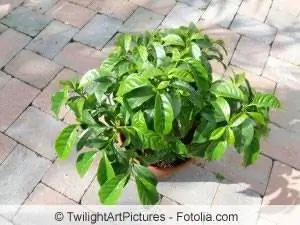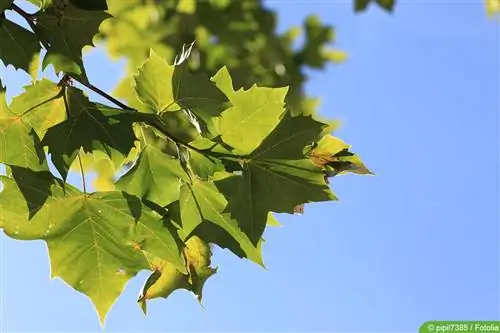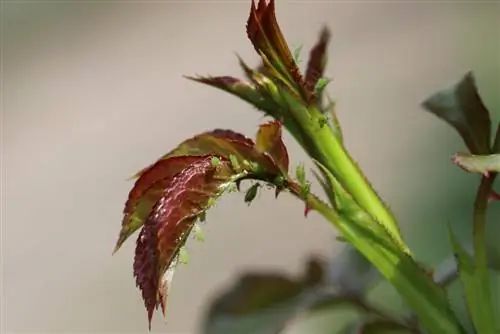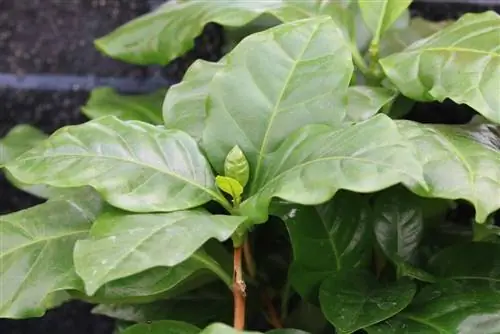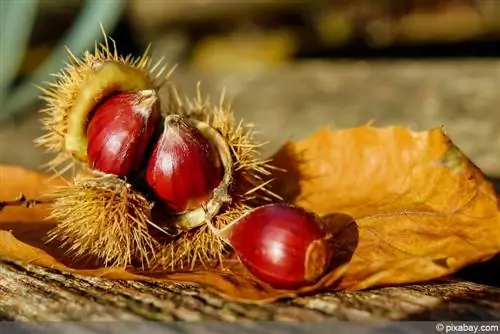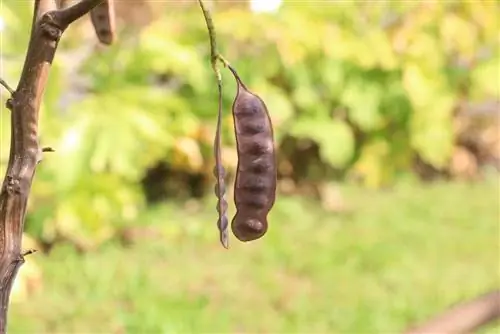- Author admin [email protected].
- Public 2023-12-17 03:39.
- Last modified 2025-01-24 12:45.
The tropical coffee tree provides the ingredient for one of the most popular drinks in the world. Hobby gardeners even enjoy the privilege of harvesting the seeds of Coffea arabica themselves and until then enjoying the decorative habit and the graceful white flowers. Of course, there is little scope for gardening oversights given the requirements for location, water and nutrient balance or overwintering. The following instructions for growing and caring for the coffee plant show that the successful cultivation of the ornamental tree does not have to remain a pious wish.
propagation by sowing
The list of challenges begins with sowing coffee seeds, because this requires both tact and a good deal of patience. You can only look forward to the first flowers after 5 years at the earliest, which culminate in the red stone fruits. You can ignore the roasted beans from your home coffee supply because they are not suitable for seeds. What is in demand are the seeds for green coffee, which you can order from special providers. Follow these steps:
- Open the fresh stone fruits to remove the seeds
- Remove the silver membrane (ligule) using tweezers
- Soak the seeds in lukewarm water for 24 hours
- Fill cultivation pots with peat sand or seed soil
- Insert one seed at a time 1-2 centimeters deep
- Moisten with low-lime water
The coffee seeds take between 4 and 8 weeks to germinate if a temperature of a constant 23 to 25 degrees Celsius can be maintained. This works best in a heated indoor greenhouse in a partially shaded location. Alternatively, put a plastic cover over each pot and place the seed containers on the warm windowsill. Once your pupils have reached a height of 4-5 centimeters, the cover is removed.
Growing with cuttings
While the seeds prove to germinate readily, the rooting of cuttings is hesitant. Only use offshoots from a summit or middle shoot, as these thrive in a tightly upright position. Cuttings taken from side branches, on the other hand, maintain their lateral orientation throughout their life, so that your coffee tree does not develop a harmonious silhouette.
- Cut off semi-woody cuttings with a length of 20-25 centimeters
- The interfaces are immersed in a natural rooting hormone, such as seaweed extract
- Remove all leaves except for the top pair of leaves
- Plant three quarters in nutrient-poor potting soil and water
- Use only one offshoot per pot
Rooting is now expected in a partially shaded location at an average of 25 degrees Celsius. A transparent hood creates a conducive, moist, warm microclimate, whereby no contact with the cuttings is permitted. The substrate must not dry out at any time. To prevent rot, watering from below is recommended. To do this, place the pot in 5-10 centimeters of water so that the substrate moistens to the surface. Once a young coffee plant has completely rooted through the pot, it is repotted into substrate for adult Coffea arabica and cared for accordingly.
Care
The coffee plant is native to the eastern regions of Africa and is now mainly grown in countries with a tropical climate, such as Brazil. From the natural distribution areas it can be concluded that Coffea arabica in Central Europe is only suitable for indoor cultivation, combined with the highest demands on the indoor climate. All the important framework conditions for successful care of coffee plants grown by yourself or purchased ready-made are highlighted below:

Location
Looking at the extensive plantations of South America, where there is no shade anywhere, it is reasonable to assume that Coffea arabica has no problems with full sunshine. In fact, the premium varieties are planted under shade trees, because the wild species also thrive as undergrowth plants. This measure is also considered the most effective control measure against coffee rust, a fungal infection widespread in the tropics. The optimal location should therefore be like this:
- Partially shaded location on the east or west window of the building
- In the winter garden or greenhouse under the protection of taller trees
- In summer at temperatures above 20 degrees Celsius in a sheltered place outdoors
- During the winter a bright place not below 15 degrees Celsius
Regular spraying with lime-free water at room temperature makes a significant contribution to the vital growth of a coffee tree. This care measure should be carried out all year round, regardless of the season.
Tip:
If the light falls unevenly on a coffee plant, it is rotated by a quarter every 5 days. This care is rewarded with an even growth habit and prevents unsightly curling. Automatic turntables do this work very conveniently.
Substrate
The coffee tree prefers an acidic potting soil, similar to rhododendron or heather. In addition, the substrate should be well ventilated, for which various additives are suitable. These components make excellent mixtures:
- 2 parts ericaceous soil, 1 part sand, 1 part expanded clay or lava granules
- 2 parts cactus soil, 1 part coconut hum, 1 part perlite
- 3 parts standard soil (peat growing substrate), 2 parts lava granules, 1 part expanded clay
The addition of a handful of horn shavings ensures that there is an adequate supply of nutrients in the substrate.
Tip:
You can avoid the unpredictability of caring for it in soil if the coffee plant thrives in hydroponics right from the start.
Pouring
All efforts to create acidic potting soil will come to nothing if the coffee tree is confronted with calcareous tap water. It is therefore important to cover the water needs of Coffea arabica as follows:
- Keep the root ball constantly moist from March to November
- Only use collected rainwater or decalcified tap water as irrigation water
- Pond and aquarium water are also suitable for watering
- From December to February, water the plant less frequently without letting the substrate dry out
To ensure that the entire root ball is moistened, water until the water runs out of the soil opening. Otherwise, the upper half of the ball will be wet while the roots in the lower area will dry out. Before the next watering session, wait until the thumb sample shows a dried substrate surface.
Care for the coffee tree in a saucer, fill it with pebbles and leave the excess water in it. This measure contributes to the creation of a warm, humid microclimate due to the evaporating moisture.
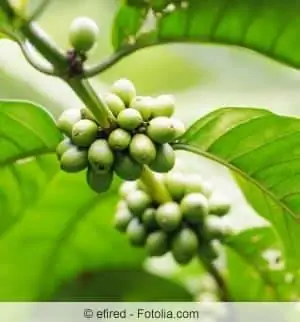
Fertilize
Organic fertilizers are recommended for proper nutrient supply, as this does not lead to salinization of the substrate. From March to early September, apply an organic liquid fertilizer every 2 weeks or use guano sticks at the dosage according to the manufacturer's instructions. Ideally you have access to organic worm tea or liquid compost.
Although Coffea arabica does not actually hibernate, the need for nutrients decreases due to the lower temperatures and lower lighting conditions. It is therefore advisable to stop applying fertilizers from October to February.
Cutting
A coffee plant has the growth power of a tree up to a height of 5 meters and more. Since such sizes make little sense in cultivation behind glass, regular cutting serves to specifically control growth. A well-suited date is the days and weeks in spring before the new shoots appear. Use sharp, disinfected scissors to cut back branches that are too long just above a leaf node.
- A coffee tree is inherently very pruning-friendly. As a useful plant, the coffee tree is always cut so that it receives enough light in all places.
- If you want to prune your coffee tree, you should do so in spring. If the shoot tips are shortened, further growth will be bushier.
- A strong pruning is recommended if the coffee tree has bare branches due to leaf drop. Then the shortening can be quite severe; same with a height cut.
If you give your coffee tree care and attention, you create the basis for it to thrive. This means that after a few years you will have to cut down the coffee tree because otherwise it will hit the ceiling.
Repotting
Every 2 to 3 years, the care program includes switching to a larger container. Again, spring comes into consideration as a date, shortly after the winter break. How to repot correctly:
- Create a drainage system made of pottery shards or grit over the water drain in the new pot
- Fill in the recommended substrate up to half the height of the bucket and press it down
- Unpot the coffee tree and place it in the middle of the fresh soil
- A largely dry root ball is easier to remove from the pot
- Fill the cavity with the remaining potting soil so that a watering edge remains free
After watering, the coffee plant is allowed to recover in a partially shaded place for 1-2 weeks. If pre-fertilized substrate is used, the first fertilizer is applied after 6 weeks at the earliest.
Conclusion
The tropical coffee tree not only provides the sought-after coffee beans, but also impresses with its decorative, evergreen habit and distinctive flowers. Reason enough to cultivate the exotic in the living room, winter garden or greenhouse. With a little gardening experience and these instructions for growing and caring for the coffee plant, the dream of your own harvest of aromatic beans from the legendary Coffea arabica is within reach.

